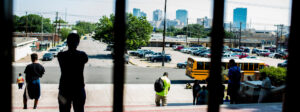In The Opportunity Myth, we make the case that access to four key resources is critical to the quality of students’ experiences in school, and to their success. Among those four resources are access to rigorous, grade-appropriate assignments, as well as the chance to do the thinking in their lessons.
But does more rigor inevitably mean less innovation?
Some folks in the field think there’s a tension between the two, but I don’t see it that way. For our students to succeed, we need to improve what they’re working on today by raising the rigor of their assignments—even as we address the fundamental design challenge of how to better serve more students, more often, at scale. As we try big, bold new approaches—which we should—we must also hold fast to some fundamentals, including giving all students, and most especially underserved students, the chance to master grade-level standards.
To get that chance, students don’t need assignments to be grade-appropriate 100 percent of the time—or even three-quarters of the time. In fact, in the very best classrooms we observed in The Opportunity Myth, students spent roughly half of their time on grade-appropriate assignments, and that made a real difference—about six months of additional learning for kids who started the year behind—relative to classrooms where students had those opportunities less often. That still leaves plenty of time for intentionally designed remediation, for tapping into student’s individual interests and strengths to guide the arc of their learning, and for making sure students’ experiences in school leave them feeling successful and proud. Demanding more grade-appropriate content for students needn’t undermine their opportunities for rich, joyful, and diverse learning experiences. That’s a false choice, as we saw in our study: Students in classrooms with instruction that allowed them to do the thinking on rigorous assignments had roughly 30 percent more engaging experiences than students in classrooms with weaker instruction.
But it’s indefensible that across all the classrooms in our study, students—94 percent of whom aspire to college and beyond—spent nearly three-quarters of their time on content that was not appropriate for their grade. It was even worse in classrooms serving mostly students of color: In nearly 40 percent of classrooms with a majority of kids of color, students never received a single grade-level assignment. That sort of inequity is unconscionable, regardless of model or classroom design.
There’s tremendous potential in new models that are doing both things at once: raising the rigor of students’ academic content and delivering more engaging learning experiences—and that’s what we should all be reaching for. Look at Zearn, a K-5 math curriculum provider that focuses on intentional differentiation in classrooms, while ensuring Common Core alignment. Or EL Education, a curriculum provider trying to change the way students experience school, while keeping the bar for rigor high. Or Haven Academy in the Bronx, a charter school set up to serve primarily students involved in New York City’s foster care system, where a personalized learning pilot built around a rigorous ELA curriculum is giving students true agency over what they work on and how they work. There are plenty of others, and we continue to believe deeply in the promise of this work.
But, bottom line, the students in The Opportunity Myth, and those we serve in our work across the country are generally doing work that was below grade-level and not as a result of intentional strategies about how to move them along to ultimately access grade-level content. Instead, students are getting low-level content through a lack of training, prioritization and/or belief that they can succeed at a high level. And that’s unacceptable.
So let’s continue to support bold innovation and nurture big ideas—we need far more of them to overcome obstacles to excellence and equity. And let’s make sure that as a field, every choice we make is grounded in the substance of what students are doing each day, whether their experiences are engaging and are putting them track to reach their goals.
Above all, let’s not buy into the argument that we have to choose between the rigor and innovation: We need to hit the gas on both.





